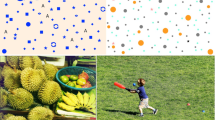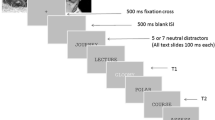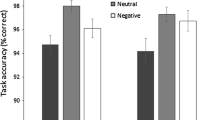Abstract
In an attempt to investigate the impact of positive emotions on visual attention within the context of Fredrickson’s (1998) broaden-and-build model, eye tracking was used in two studies to measure visual attentional preferences of college students (n=58, n=26) to emotional pictures. Half of each sample experienced induced positive mood immediately before viewing slides of three similarly-valenced images, in varying central-peripheral arrays. Attentional breadth was determined by measuring the percentage viewing time to peripheral images as well as by the number of visual saccades participants made per slide. Consistent with Fredrickson’s theory, the first study showed that individuals induced into positive mood fixated more on peripheral stimuli than did control participants; however, this only held true for highly-valenced positive stimuli. Participants under induced positive mood also made more frequent saccades for slides of neutral and positive valence. A second study showed that these effects were not simply due to differences in emotional arousal between stimuli. Selective attentional broadening to positive stimuli may act both to facilitate later building of resources as well as to maintain current positive affective states.

Similar content being viewed by others
References
Aspinwall, L. G., & Brunhart, S. M. (1996). Distinguishing optimism from denial: Optimistic beliefs predict attention to health threats. Personality and Social Psychology Bulletin, 22, 993–1003.
Basso, M. R., Schefft, B. K., Ris, M. D., & Dember, W. N. (1996). Mood and global-local visual processing. Journal of the International Neuropsychological Society, 2, 249–255.
Baumeister, R. F., Muraven, M., & Tice, D. M. (2000). Ego depletion: A resource model of volition, self-regulation, and controlled processing. Social Cognition, 18(2), 130–150.
Berlyne, D. E. (1958). The influence of complexity and novelty in visual figures on orienting responses. Journal of Experimental Psychology, 55, 289–296.
Bradley, B. P., Mogg, K., & Lee, S. C. (1997). Attentional biases for negative information in induced and naturally occurring dysphoria. Behavioral Research Therapy, 35, 911–927.
Bradley, B. P., Mogg, K., & Millar, N. H. (2000). Covert and overt orienting of attention to emotional faces in anxiety. Cognition and Emotion, 14, 789–808.
Buckley, T. C., Blanchard, E. B., & Hickling, E. J. (2002). Automatic and strategic processing of threat stimuli: A comparison between PTSD, panic disorder, and non-anxiety controls. Cognitive Therapy and Research, 26, 97–115.
Carnevale, P. J. D., & Isen, A. M. (1986). The influence of positive mood and visual access on the discovery of integrative solutions in bilateral negotiation. Organizational Behavior and Human Decision Processes, 37, 1–13.
Center for the Study of Emotion and Attention [CSEA-NIMH] (1999). International affective picture system: Digitized photographs. Gainsville, FL: The Center for Research in Psychophysiology, University of Florida.
Charles, S. T., Mather, M., & Carstensen, L. L. (2003). Aging and emotional memory: the forgettable nature of negative images for older adults. Journal of Experimental Psychology, 132, 310–324.
Derryberry, D., & Tucker, D. M. (1994). Motivating the focus of attention. In P. M. Neidenthal & S. Kitayama (Eds.), The heart’s eye: Emotional influences in perception and attention (pp. 167–196). San Diego, CA: Academic Press.
Estrada, C. A., Isen, A. M., & Young, M. J. (1997). Positive affect facilitates integration of information and decreases anchoring in reasoning among physicians. Organizational Behavior and Human Decision Processes, 72, 117–135.
Fredrickson, B. L. (2003). The value of positive emotions. American Scientist, 91, 330–335.
Fredrickson, B. L. (2001). The role of positive emotions in positive psychology. American Psychologist, 56, 218–226.
Fredrickson, B. L. (2000a). Cultivating positive emotions to optimize health and well-being. Prevention and Treatment, 3, Article 0001a. Retrieved January 1, 2003, from http://journals.apa.org/ prevention/volume3/pre0030001a.html
Fredrickson, B. L. (2000b). Cultivating positive emotions to optimize health and well being. Prevention and Treatment, 3, Article 0001a. Retrieved January 1, 2003, from http://journals.apa.org/ prevention/volume3/pre0030001a.html
Fredrickson, B. L. (1998). What good are positive emotions? Review of General Psychology, 2, 300–319.
Fredrickson, B. L., & Joiner, T. (2002). Positive emotions trigger upward spirals towards emotional well-being. Psychological Science, 13, 172–175.
Fredrickson, B. L., & Levenson, R. W. (1998). Positive emotions speed recovery from the cardiovascular sequelae of negative emotions. Cognition and Emotion, 12, 191–220.
Fredrickson, B. L., Mancuso, R. A., Branigan, C., & Tugade, M. M. (2000). The undoing effect of positive emotions. Motivation and Emotion, 24, 237–259.
Gasper, K., & Clore, G. L. (2002). Attending to the big picture: Mood and global versus local processing of visual information. Psychological Science, 13, 34–40.
Handley, I. M., Lassiter, G. D., Nickell, E. F., & Herchenroeder, L. M. (2004). Affect and automatic mood maintenance. Journal of Experimental Social Psychology, 40, 106–112.
Hermans, D., Vansteenwegen, D., & Eelen, P. (1999). Eye movement as a continuous index of attention deployment: Data from a group of spider anxious students. Cognition and Emotion, 13, 419–434.
Isaacowitz, D. M. (2005). The gaze of the optimist. Personality and Social Psychology Bulletin, 31, 407–415.
Isaacowitz, D. M. (in press). The Oxford Handbook of Methods in Positive Psychology. In A. Ong & M. van Dulmen (Eds.), Positive psychology and measurement. New York: Oxford University Press.
Isen, A. M., & Daubman, K. A. (1984). The influence of affect on categorization. Journal of Personality and Social Psychology, 47, 1206–1217.
Isen, A. M., Daubman, K. A., & Nowicki, G. P. (1987). Positive affect facilitates creative problem solving. Journal of Personality and Social Psychology, 52, 1122–1131.
Isen, A. M., Johnson, M. M. S., Mertz, E., & Robinson, G. F. (1985). The influence of positive affect on the unusualness of word associations. Journal of Personality and Social Psychology, 48, 1413–1426.
Isen, A. M., Niedenthal, P. M., & Cantor, N. (1992). An influence of positive affect on social categorization. Motivation and Emotion, 16(1), 65–78.
Isen, A. M., Nygren, T. E., & Ashby, F. G. (1988). Influence of positive affect on the subjective utility of gains and losses: It is just not worth the risk. Journal of Personality and Social Psychology, 55(5), 710–717.
Isen, A. M. (2000). Part V: Cognitive factors. In M. Lewis & J. M. Haviland-Jones (Eds.), Handbook of emotions (2nd ed., pp. 417–520). New York: Guilford Press.
Kahn, B. E., & Isen, A. M. (1993). The influence of positive affect on variety seeking among safe, enjoyable products. Journal of Consumer Research, 20(2), 257–270.
LaBar, K. S., Mesulam, M. M., Gitelman, D. R., & Weintraub, S. (2000). Emotional curiosity: Modulation of visuospatial attention by arousal is preserved in aging and early-stage Alzheimer’s disease. Neuropscyhologia, 38, 1734–1740.
Larsen, J. T., Hemenover, S. H., Norris, C. J., & Cacioppo, J. T. (2003). Turning adversity into advantage: On the virtues of the coactivation of positive and negative emotions. In L. G. Aspinwall & U. M. Straudinger (Eds.), A psychology of human strengths: Fundamental questions and future directions for a positive psychology (pp. 211–255). Washington, DC: American Psychological Association.
MacLeod, C., Mathews, A., & Tata, P. (1986). Attentional bias in emotional disorders. Journal of Abnormal Psychology, 95, 15–20.
Mogg, K., McNamara, J., Powys, M., Rawlinson, H., Seiffer, A., & Bradley, B. P. (2000). Selective attention to threat: A test of two cognitive models of anxiety. Cognition and Emotion, 14, 375–399.
Mogg, K., Millar, N., & Bradley, B. P. (2002). Biases in eye movements to threatening facial expressions in generalized anxiety disorder and depressive disorder. Journal of Abnormal Psychology, 109, 695–704.
Parkhurst, D., Law, K., & Niebur, E. (2002). Modeling the role of salience in the allocation of overt visual attention. Vision Research, 42, 107–123.
Radloff, L. S. (1977). The CES-D scale: A self-report depression scale for research in the general population. Applied Psychological Measurement, 1, 385–401.
Reed, M. B., & Aspinwall, L. G. (1998). Self-affirmation reduces biased processing of health-risk information. Motivation and Emotion, 22, 99–132.
Rudd, M. D., Joiner, T., & Rajab, M. H. (2001). Treating behavior: An effective time-limited approach. New York: Guilford.
Scheier, M. F., & Carver, C. S. (1985). Optimism, coping, and health: Assessment and implications of generalized coping expectancies. Health Psychology, 4, 219–247.
Spielberger, C. D., Gorsuch, R. L., Lushene, R., Vagg, P. R., & Jacobs, G. A. (1983). Manual for the state-trait anxiety inventory. Palo Alto, CA: Consulting Psychologists Press.
Veenhoven, R. (1988). The utility of happiness. Social Indicators Research, 20, 333–354.
Watson, D., Clark, L. A., & Tellegen, A. (1988). Development and validation of brief measures of positive and negative affect: The PANAS scales. Journal of Personality and Social Development, 54, 1063–1070.
Wegener, D. T., & Perry, R. E. (1994). Mood management across affective states: The hedonic contingency hypothesis. Journal of Personality and Social Psychology, 66, 1034–1048.
Williams, J. M. G., Watts, F. N., MacLeod, C., & Mathews, A. (1997). Cognitive psychology and emotional disorders (2nd ed.). New York: Wiley.
Acknowledgement
This work was supported by National Institute of Health Grant R03 AG022168-01 awarded to Derek M. Isaacowitz.
Author information
Authors and Affiliations
Corresponding author
Rights and permissions
About this article
Cite this article
Wadlinger, H.A., Isaacowitz, D.M. Positive mood broadens visual attention to positive stimuli. Motiv Emot 30, 87–99 (2006). https://doi.org/10.1007/s11031-006-9021-1
Received:
Accepted:
Published:
Issue Date:
DOI: https://doi.org/10.1007/s11031-006-9021-1




